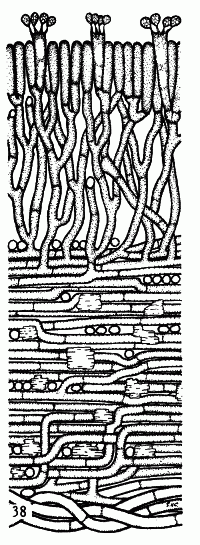|
 Phanerochaete cordylines Phanerochaete cordylines
SynonymsCorticium cordylines
Phanerochaete cordylines
BiostatusPresent in region - Indigenous. Endemic
Images (click to enlarge)
Caption: TEXT-FIG. 38. Corticium cordylines. x 500. |
Article: Cunningham, G.H. (1954). Thelephoraceae of New Zealand. Part III: the genus Corticium. Transactions of the Royal Society of New Zealand 82(2): 271-327.
Description: Hymenophore annual, membranous, fragile, loosely attached, effused, forming orbicular or
irregular areas to 10 x 4 cm.; surface flesh-pink, or pinkish-buff, becoming tinged vinaceous,
colliculose, creviced irregularly, mainly centrally when dry; margin thinning out, white, to 3
mm. broad, fibrillose, loosely attached. Context pallid pink, 250-350 µ thick, composed of a
stout basal layer of mainly parallel hyphae densely compacted and embedded in masses of
crystals, hyphae in contact with the substratum thickened, partly sclerotioid and densely
woven, intermediate layer of loosely arranged mainly upright hyphae embedded in scattered
crystals; generative hyphae 3.5-4 µ diameter, 6-7 µ at the base, wall 0.25 µ thick, naked,
hyaline, branched, septate, without clamp connections. Hymenial layer to 50 µ deep, of
basidia and paraphyses forming a dense palisade. Basidia subclavate, projecting slightly,
16-26 x 4-5 µ, 4-spored; sterigmata slender, to 5 µ long. Paraphyses cylindrical or subclavate,
narrower than the basidia. Spores obovate, or pip-shaped, 4.5-6 x 3-3.5 µ, apiculate, wall
smooth, hyaline, 0.2 µ thick.
Habitat: HABITAT. Effused on bark of dead stems.
Distribution: DISTRIBUTION. New Zealand.
Notes: Specific features are the loosely attached hymenophore with broad fibrillose margin, flesh-pink becoming vinaceous colliculose surface,
small obovate or pip-shaped spores and broad
basal layer of the context. Where in contact with the substratum hyphae are densely woven,
sclerotioid and walls are thickened to 1 µ. Crystals are embedded freely in the basal layer and
scattered through the intermediate layer, but do not occur in masses as in C. seutellare, C.
tuberculatum, and related species.
Article: Stalpers, J.A. (1985). Type studies of the species of Corticium described by G.H. Cunningham. New Zealand Journal of Botany 23(2): 301-310 (http://www.rsnz.org/publish/abstracts.php).
Description: Basal layer strongly developed, consisting of hyaline, thin- to slightly thick-walled hyphae, 3-5.5(-7.5) µm wide, without clamps. Cystidia absent. Spores hyaline, thin-walled, smooth,
ellipsoid to pip-shaped, 4.5-6.5 x 3.5-4.5 µm.
Notes: The species causes a white rot and belongs to Phanerochaete P. Karst. It is close to Ph.
tuberculata (P. Karst.) Parm., but differs from this species in the pink to vinaceous colour and
the slightly wider spores.
|